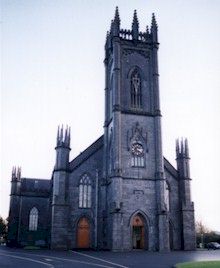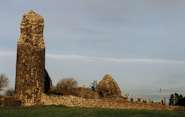 Local
Attractions in and about Tuam Local
Attractions in and about Tuam
Tourism in Tuam had
very small beginnings. It started with the establishment of the
Mill Museum which was opened to the public in
1974. This old mill
is now the only water powered preserved corn mill in the West of
Ireland which is still operated as a voluntary community project.
Since 1983 a seasonal tourist
information office is operated from the Mill Museum.
In addition, the Mill Museum
operates walking tours of the Town for visiting groups and covers all the
historical aspects of the Town. These tours start at Abbeytrinity Car
Park. This car park takes its name from the Premonstratention abbey which
was established in Tuam during the latter part of the 12th century. From
this car park the visitors are brought through the Town, stopping at
interesting points along the way, the first stop being The Chair of Tuam,
then on to the largest house in the Town which at one time was the
residence of the Church of Ireland Archbishops and later Bishops of Tuam.
The building was vacated in the early 1950's and was for a time used a
sleeping quarters for the boarders at Presentation College, Currylea until the boarders were phased out in the early 1990's. It was then taken
over by a local Supermarket owner, beautifully restored and now has a
restaurant on the ground floor known as The Palace Restaurant. This house
was built between 1716 and 1741 by Archbishop Edward Synge as is still the
largest house in the Town.
The Community Centre, which
is adjacent to the Palace was at one time the stables and servants
quarters. The building now serves as the local community centre and also
houses a number of community and private business projects.
 As
visitors walk towards the Roman Catholic Cathedral they will notice that
on either side of the Cathedral there are a number of schools.
St. Jarlath's College (est.1800), Presentation Convent (est. 1835),
Sisters of Mercy Convent (est. 1846) and St. Patrick's College (est. 1851
by the Irish Christian Brothers). In addition, there is another school,
the John MacHale vocational school ( est. 1937). As
visitors walk towards the Roman Catholic Cathedral they will notice that
on either side of the Cathedral there are a number of schools.
St. Jarlath's College (est.1800), Presentation Convent (est. 1835),
Sisters of Mercy Convent (est. 1846) and St. Patrick's College (est. 1851
by the Irish Christian Brothers). In addition, there is another school,
the John MacHale vocational school ( est. 1937).
The Catholic Cathedral was
built between 1827 and 1836 during a famine period in parts of the West of
Ireland. The building of the Cathedral was commenced by Archbishop Oliver
Kelly, Archbishop of Tuam 1815 to 1834 and it was completed By Archbishop
Oliver MacHale, Archbishop of Tuam 1834 to 1881. There are many
interesting facets to this limestone building, the classic faces around
the windows the humerous faces at the rear of the Cathedral and the stain
glass windows by The Harry Clarke studios which date from the early 20th
century.
The Town centre, which was
laid out in the early 17th century following the granting of a royal
charter by King James the first of England has the Town Hall as its centre
piece. This building was originally built in 1853 and is currently being
modernised. Opposite the Town Hall is The Imperial Hotel which has served
as a hotel in Tuam since the 19th century.
 Teample Jarlath (The place of
Jarlath) is the next stop for visitors and here we can see the remnants of
the earliest monastic settlement which established Tuam as a population
centre. Teample Jarlath (The place of
Jarlath) is the next stop for visitors and here we can see the remnants of
the earliest monastic settlement which established Tuam as a population
centre.
Tradition has it that Jarlath
was a member of a large religious community at Cloonfush and Kilbannon
which are areas a few miles outside the Town. In time, Jarlath's life
became uncertain as he wished to travel and establish his own monastery.
Eventually his abbot St. Benin bade him "Go, and where ever your
chariot wheel breaks, there shall be the site of your new monastery and
the place of your resurrection". So it was that Jarlath's wheel broke
in the area that is now called Temple Jarlath.
This was the first Christian
settlement in Tuam and supplanted the old pagan burial beliefs with
Christian values and beliefs as taught by St. Patrick.
 The
next stop for visitors is St. Mary's Cathedral. It is the Church of
Ireland Cathedral in Tuam and parts of this building date from the 12th,
14th and 19th centuries. The
next stop for visitors is St. Mary's Cathedral. It is the Church of
Ireland Cathedral in Tuam and parts of this building date from the 12th,
14th and 19th centuries.
This Cathedral also houses The High Cross of Tuam which was erected in the
south transept of the 19th century building. St. Mary's also houses a
cross shaft which also dates from the 12th century.
The cross head from St.
John's Abbey which also dates from the 12th century is housed in the Synod
Hall, the fourteenth century building. St. Mary's has many
interesting features which include the 19th century stain glass windows by
McAlister, housed in the Synod Hall and the late 19th century stain glass
windows in the 19th century building, some depicting the faces of real
people, one time parishioners in the Cathedral.
Major renovations took place
at St. Mary's Cathedral from 1985 to 1993 and an all new central heating
system was installed during September 2000.
The last stop on the walking
tour of the Town is a visit to The Mill Museum with its still working
water wheel and machinery still intact. The Museum was established as a
voluntary community project in 1974 and still continues as such. It is the
only preserved working corn mill in the West of Ireland and its history
dates back the the late 17th century.
Ballytrasna /
Gardenfield Golden Mile
The
residents of Ballytrasna / Gardenfield are in possession of one of the
most beautiful miles’ in the whole County. The village is located
just 2 miles north of Tuam, just off the main N17 road and visitors
are always welcome to stroll along our mile. Here you will find many
places of interest including ringforts, the famous “Lally’s
monument”, a natural bird sanctuary, a mass path, a lost village,
the Holy Year Cross, an old village pump, many groves of trees that
came from the 4 corners of the globe, a large Turlough, two National
Schools (old & new) and much more.
Clais an Aifrinn
During the penal laws Mass was not publically celebrated in Tuam .In Sylane,
near Tuam there is an open pit called Clais an Aifrinn in
which an altar and cross is erected to commerate the time when Fr Ulick
Nally,
P.P Cummer celebrated Mass there for his people.
-
Mill
Museum an audio visual museum
containing a restored corn mill with operating water wheel.
-
Chair
of Tuam part of the O’Connor castle, located in
O’Tooles car park.
-
Teampall
Jarlath 13th century parish
church ruins and graveyard.
-
Palace
Grounds a beautiful maintained scenic
park with picnic area and 2km walkway through the trees.
-
St.
Mary’s Cathedral and Synod Hall incorporating
the chancel and Hiberno-Romanesque arch of a former Cathedral.
Location : High St.
-
Cathedral
of the Assumption the
location at which St Jarlaths chariot wheel came undone.
-
Cloonfush
Graveyard reputed to be the starting point of St
Jarlath’s journey. Directions – from town centre, 1km towards
Galway, first turn right, 2km to end of road.
-
Clas
an Aifrinn ,where Mass was celebrated in Penal Times.
Directions – from town centre, .5km towards Galway, first turn right
at lights, 2km to Sylane.
-
Castlehackett
reputed to be the burial spot of Queen Maeve.
Directions – from town centre, 2km towards Galway, 2nd turn
right, sign posted for Belclare 1km in that road.
Nearby Attractions
Attraction within
driven distance include :
-
Croagh
Patrick
-
Knock
-
Connemara
-
The
Shannon
-
The
Burren
Local
Golf Clubs
Tuam
Golf Club - Website
Dunmore
Demesne
Athenry Golf Club
Claremorris Golf Club
Mountbellew Golf Club
Click for more
County
Galway Tourism
|



